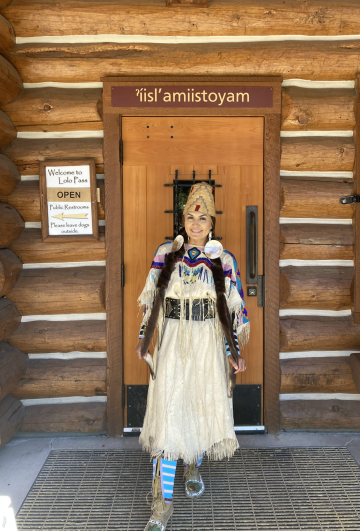NATIVE Act funds help reestablish ancient place name: wispin’íitpe
WASHINGTON, DC—On Saturday, June 25, 2022, among a sea of blooming purple qéḿes flowers, over 300 people gathered for a place naming ceremony to reintroduce the traditional Nez Perce names to various sites along the Nez Perce Historic Trail. The naming ceremony took place at wispin’íitpe, which means “as one travels out of the timber, upon coming over the divide” in the Nez Perce language. Known as Packer Meadows in English, wispin’íitpe is located near the Lolo Pass Visitor Center on the Nez Perce-Clearwater National Forest. The visitor center is collaboratively managed by the Nez Perce Tribe, national forest staff, the Nez Perce (Nee-Me-Poo) National Historic Trail and the Nez Perce National Historical Park.
The place naming ceremony was the kick-off of nearly 30 places that will be renamed in partnership with Nez Perce tourism, Nez Perce Tribe, Shoshone-Bannock Tribes, Nez Perce-Clearwater National Forest, and the Nez Perce (Nee-Me-Poo) National Historic Trail.
The powerful beat of the waapqaqán (young golden eagle) drum provided the pulse of the ceremony, initiating the event with an ancient traditional song. The procession of Nimiipuu veterans with feathered headdresses posted the flags of the Nez Perce Tribe and the United States while the Nimiipuu flag song echoed across the meadow. From the east of the meadow appeared a continual parade of horses and riders dressed in traditional regalia expressing their culture and identity.
A welcome by Nakia Williamson, director of Nez Perce Tribe Cultural Resource Program, included an explanation of the significance of wispin’íitpe: “Fundamentally, Nimiipuu place names are a reminder of the accountability that the Nimiipuu have to the land and its resources. The relationship Nimiipuu have maintained over generations is fundamental to their existence and the law which governs their actions upon this landscape provides the basis for this to occur. It is through this understanding of ‘relationship’ that Nimipuu people derive culture and identity.”
The ceremony included statements by Samuel Penney, Nez Perce Tribe Executive Committee chairman, and several Forest Service staff: Cheryl Probert, acting deputy regional forester for the Northern Region; Toby Bloom, national program manager for Travel, Tourism and Interpretation; and Sandra Broncheau-McFarland, administrator of the Nez Perce (Nee-Me-Poo) National Historic Trail. After these statements, witnesses to the ceremony were invited to taste prepared qéḿes—smoked for three days underground during which complex carbohydrates are transformed into fructose. The naming ceremony followed, an ancient protocol confirmed by the Nez Perce Tribe Circle of Elders.
In addition to the naming ceremony itself, the day also included the dedication and blessing of a life-size metal sculpture and honoring of artist Abe Yearout on the plaza of the Lolo Pass Visitor Center. His sculptures can be found at several locations along the trail and help visitors imagine the original inhabitants of this area.
Funds for this project were provided by the Forest Service through the NATIVE Act. The Native American Tourism & Improving Visitor Experience Act, or Public Law 114-221, was enacted in 2016, and serves to establish a more inclusive national travel and tourism strategy with the potential to deliver significant benefits for tribes, including jobs creation, elevated living standards and expanded economic opportunities. In 2021, the Forest Service became the first federal land management agency to receive a Congressional allocation of NATIVE Act funding to implement tribal tourism and interpretation projects with Forest Service tribal partners.



